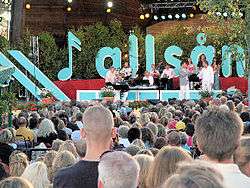Sveriges Television
Sveriges Television AB (SVT, Swedish pronunciation: [ˈsvæ̌rjɛs tɛlɛvɪˈɧuːn] (![]()
 | |
| Type | Public television broadcaster |
|---|---|
| Country | Sweden |
| Availability | National |
| Founded | 1956 (as Sveriges Radio TV) 1979 (as SVT) |
| Slogan | Fri television ("Free Television") |
| Owner | Förvaltningsstiftelsen för Sveriges Radio AB, Sveriges Television AB och Sveriges Utbildningsradio AB |
Key people | Göran Johnsson, Chairman of the board Hanna Stjärne, Chief executive officer |
Launch date | 4 September 1956 |
Former names | Radiotjänst (1956–1957) Sveriges Radio (1957–1979) |
Channels | SVT1, SVT2, SVT24, SVT Barn, Kunskapskanalen |
| Affiliates | European Broadcasting Union |
Official website | www |
SVT is a public limited company that can be described as a quasi-autonomous non-government organisation. Together with the other two public broadcasters, Sveriges Radio and Sveriges Utbildningsradio, it is owned by an independent foundation, Förvaltningsstiftelsen för Sveriges Radio AB, Sveriges Television AB och Sveriges Utbildningsradio AB. The foundation's board consists of 13 politicians, representing the political parties in the Riksdag and appointed by the Government. The foundation in turn appoints the members of the SVT board. SVT's regulatory framework is governed by Swedish law. Originally, SVT and Sveriges Radio were a joint company, but since 1979 they and Sveriges Utbildningsradio are sister companies sharing some joint services.
SVT maintained a monopoly in domestic terrestrial broadcasting from its start in 1956 until the privately held TV4 started broadcasting terrestrially in 1992. It is barred from accepting advertisements except in the case of sponsors for sporting events. Until the launch of the Swedish language satellite television channel TV3 in 1987, Sveriges Television provided the only Swedish television available to the public. SVT is still the biggest TV network in Sweden, with an audience share of 36.4 percent.
History
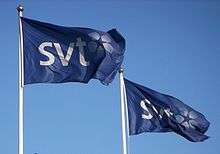
When radio broadcasting was first organized in the 1920s, it was decided to adopt a model similar to that of the British Broadcasting Company in the United Kingdom. Radio would be a monopoly funded by a licence fee and organized as a limited company, AB Radiotjänst ("Radio Service Ltd."), owned by the radio industry and the press.[2] The transmitters were owned by the state through Telegrafverket and the press held a monopoly on newscasts through Tidningarnas Telegrambyrå. AB Radiotjänst was one of 23 founding broadcasting organizations of the European Broadcasting Union in 1950.
Tidningarnas Telegrambyrå lost its monopoly on newscasts de jure in 1947 and de facto in 1956, but otherwise the same model would be applied to television.[3]
It was decided to start test transmissions of television in June 1954. The first transmissions were made on 29 October 1954 from the Royal Institute of Technology in Stockholm.[3]
In 1956 the Riksdag decided that television broadcasting should continue on a permanent basis and on 4 September Radiotjänst initiated official transmissions from the new Nacka transmitter. A television licence for those owning a television set was introduced in October of that year.[3]

Regularly scheduled television programming began in 1957. At the same time, Radiotjänst was renamed Sveriges Radio (SR) and its ownership was changed. The state and the press would have equal 40% shares, while the company itself would own 20% (in 1967, the state increased its share to 60% at the expense of the press).
In 1958, the first newscast, Aktuellt, was broadcast. During the 1960s the establishment of a second TV channel was frequently discussed. These discussions resulted in the launch of TV2 on 5 December 1969. The original channel became TV1 and it was intended that the two channels would broadcast in "stimulating competition" within the same company.[4]
The first stage of the main headquarters building and TV studios for Sveriges Television, called TV-huset (sv), was inaugurated on Oxenstiernsgatan in the Östermalm district in Stockholm on 30 October 1967. The completion of the second stage of TV-huset and its official opening was on 5 December 1969, the same day as the start of operations of TV2, making it one the largest television studios in Europe at that time.
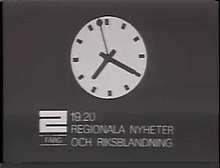
1970 saw the start of the first regional programme, Sydnytt from Malmö. More regional news programmes launched in 1972 and the entire country was covered by regional news programmes by 1987 when ABC from Stockholm began.
When TV2 started the news programmes were reorganized. Aktuellt was replaced by TV-nytt, which was responsible for the main 19.30 bulletin on TV1 as well as news updates on both channels. In addition, the two channels would get one "commentary bulletin" each. TV2's was entitled Rapport and TV1's was Nu.[5]
In 1972, the news was reorganized once again. Rapport was moved to the 19.30 slot on TV2 while Aktuellt was revived, to broadcast at 18.00 and 21.00 on TV1.[6] These timeslots would mostly stay unchanged for the following decades.
In 1966, the first colour broadcast was made, with regular colour broadcasts being introduced in 1970. Teletext started in 1978.

At the end of the 1970s, SR was reorganized. From 1 July 1979, Sveriges Radio AB became the mother of four companies: Sveriges Riksradio (RR) for national radio, Sveriges Lokalradio AB (LRAB) for local radio, Sveriges Utbildningsradio (UR) for educational broadcasting and Sveriges Television (SVT) for television. SVT would provide all television broadcasting, except for educational programming which was the responsibility of Sveriges Utbildningsradio. The abbreviation SVT was chosen over the arguably more logical "STV" as that abbreviation was already occupied by Scottish Television in the EBU.[7] The Swedish EBU membership is currently jointly held by SVT, SR and UR.
The two channels were reorganized in 1987. TV1 was renamed Kanal 1 and contained almost all programmes produced in Stockholm, while TV2 consisted of the ten regional districts and the Rapport news desk.
Broadcasting in Nicam Stereo was made permanent in 1988. This year also saw the launch of a channel called SVT World in southern Finland, broadcasting content from SVT for Finland-Swedes. The channel, which was later renamed SVT4, was rebranded as SVT Europa in 1997, when it started broadcasting to all of Europe via satellite. Following its expansion into Asia and Africa, it was rebranded as SVT World in 2005.
In 1992, the Riksdag decided that Sveriges Radio would be reorganized once again, this time into three independent companies (with RR and LRAB merged). From 1994, they would be owned by three independent foundations. The three foundations later became one.[8]
In 1990, the television broadcasting day would usually begin at 16.00 and end before 24.00. The 1990s saw an increase in broadcasting hours, with the addition of reruns in the afternoon, a morning show, and lunch-time news bulletins. SVT also met competition from new commercial broadcasters. TV3 became the first channel to break SVT's monopoly on television in Sweden and in 1992 the newly elected right-wing parliamentary majority allowed TV4 to start terrestrial broadcasting. TV4 soon established nationwide coverage and in 1995 passed TV2 in the overall ratings to become the nation's most viewed channel.
In 1996, the channels were once again reorganized. The previous organization and competition between the two channels disappeared as they became part of a single organization. Kanal 1 and TV2 were renamed SVT1 and SVT2. The first season of Expedition: Robinson (Survivor) was shown in 1997.
The first digital terrestrial television (DTT) broadcasts took place in 1999. SVT started six new channels: the news channel SVT24 and five regional channels. 2000 saw the reorganization of the news desks. Aktuellt, Rapport, and SVT24 all came under the control of one central news desk.
In 2001 a new logo and new programme schedules, among other things, were introduced. This made SVT1 the broader mainstream channel with higher ratings and SVT2 the narrower channel. The main news bulletins at 19.30 and 21.00 switched channels, with Aktuellt now shown on SVT2 and Rapport on SVT1.
The regional channels were closed at the beginning of 2002 and replaced by SVT Extra. In December 2002, a new channel known as Barnkanalen began showing children's programmes during the day. On 24 February 2003 SVT24 and SVT Extra were renamed 24, a theme channel for news and sports. Also in 2003, all the SVT channels dropped their encryption in the DTT network.
On 25 June 2003, SVT broadcast its first programme with 5.1 sound on DTT. The first 5.1 show was Allsång på Skansen. In November 2004, SVT added two audio streams that read out the translation subtitles on SVT1 and SVT2. The knowledge-oriented channel Kunskapskanalen started broadcasting in September 2004.
The switch-off of analogue transmitters started in 2005 on Gotland. By 2007 all analogue transmissions from SVT had ceased.
SVT started VODcasting a number of programmes in February 2006. Altogether three broadcasters competed to be the first one to VODcast in Sweden. In the end, all three started in the same week.
SVT made its first broadcasts in high definition television during the 2006 FIFA World Cup on a channel operated in co-operation with TV4 AB. Regular high-definition broadcasting started on the SVT HD channel on 22 October 2006. The first programme was the film Lost in Translation, followed the next day by a 50th anniversary tribute to television in Sweden, which was the first live entertainment programme to be broadcast in high definition in Sweden. On 25 August 2008, new logos and channel identities were introduced on the network with Barnkanalen renamed SVTB and 24 returning to its former name of SVT24, while SVT1 began carrying Regionala Nyheter (regional news bulletins) for the first time.
SVT was the host broadcaster for the 1975, 1985, 1992, 2000, 2013, and 2016 Eurovision Song Contests.
In 2018, the Riksdag voted to replace the traditional TV licensing system with a new public-service fee based on personal income tax.[1]
Programming
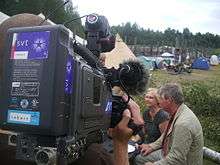
News
News programmes
News programmes are an important part of SVT. Since 1972 there have been two main news programmes: Rapport and Aktuellt (translated "Report" and "Current [events]", respectively). The two news programmes had completely separate organizations, meaning a lot of duplicated coverage was provided. After some co-operation in the 1990s, the two programmes were allowed to merge in 2000 with the newly created SVT24 to form a single organization. The different programme names and identities were kept, however. Eventually, Rapport has become the main news programme, and Aktuellt will only broadcast one bulletin per day from autumn 2007.
The main national news bulletins are Rapport, broadcast at 18.00 and 19.30, and Aktuellt which reports in greater depth at 21.00. Additionally, shorter news bulletins are shown in the mornings and throughout the day on SVT1, SVT2, and SVT24. These are styled SVT Nyheter. SVT also broadcasts video news on the Internet through a service called Play Rapport.
SVT provides news programmes in various minority languages: Uutiset in Finnish, Nyhetstecken in Swedish Sign Language, and, in co-operation with NRK and Yle, Ođđasat in Northern Sami, as well as special editions of Sverige idag in Meänkieli and Romani.[9]
There are also regional news bulletins
– on SVT1 at 18.33 on Mondays to Fridays and 18.10 on Sundays, as well as 19.55 daily except Saturdays
– on SVT2 at 21.46 on Mondays to Thursdays and 21.25 on Fridays
- ABC from Stockholm (Stockholm and Uppsala)
- Gävledala from Falun (Dalarna and Gävleborg)
- Mittnytt from Sundsvall (Västernorrland)
- Nordnytt from Luleå (Norrbotten)
- Östnytt from Norrköping (Östergötland, Södermanland and Gotland)
- Smålandsnytt from Växjö (Kronoberg, Kalmar and Jönköping)
- SVT Nyheter Jämtland from Östersund (Jämtland)
- SVT Nyheter Väst from Gothenburg (Västra Götaland and Halland)
- Sydnytt from Malmö (Skåne and Blekinge)
- Tvärsnytt from Örebro (Örebro and Västmanland)
- Värmlandsnytt from Karlstad (Värmland)
- Västerbottensnytt from Umeå (Västerbotten)
Party political orientation
A survey in 1999 claimed that 33 percent of the journalists working for SVT and SR supported the Left Party, which was about the same proportion as among journalists employed in commercial broadcasting and the print media, but significantly higher than among the general public, only 15 percent of whom supported the Left Party. Support for the Left Party, the Green Party and the Liberal Party was stronger among journalists on SVT and SR than among the general public, while the Moderate Party, the Social Democrats, and the Christian Democrats had significantly less support among SVT and SR journalists than they did among the public at large.[10] The study nevertheless concluded that the private political opinions of the journalists had little impact on their work and that news stories are treated the same regardless of the political colour of individual journalists.[10] It is also worth mentioning that SJF, the organisation amongst whose members the study was partly conducted, is a trade union, which could have skewed the representivity of the sample (lessening the validity of the survey) as it is possible it excluded some rightwing journalists. The University of Gothenburg also made another study during the Swedish 2006 general election, comparing SVT's news programme Rapport to the country's five largest newspapers. The study concluded that Rapport's coverage of the election was the most balanced of them all.[11]
Entertainment
Entertainment shows on Fridays and Saturdays are, together with popular sports, the programmes that attract the largest audiences.
- Melodifestivalen (1959-), the preselection for the Eurovision Song Contest, is very popular in Sweden. The final generally gets around 4 million viewers.
- Expedition Robinson (1997–2004, 2009–2012), the original Swedish version of Survivor. Sveriges Television was the first network to broadcast this reality television series in 1997. The show, with a name alluding to Robinson Crusoe, was a major hit in Sweden. The show which consistently held high ratings was concluded after its seventh and final year on the network (the final season aired 2003-2004). The popular series was continued on the commercial channel TV3, but with much lower ratings. Expedition Robinson was aired in 2009 with a brand new season, but the series is/was just called "Robinson", and now on the commercial channel TV4.
- På spåret (1987–present), popular entertainment show in which celebrities answer questions related to different locations. A cut down film in extremely high speed of a train journey towards the location is shown and the sooner the contestants stop it the higher the points. In later years even car journeys has been filmed that way. Humouristic and well hidden clues are given verbally during the journey. The name of the show means "on the track" in English. The show is one of very few Swedish original ideas. It has been syndicated in other countries as well.
- Så ska det låta (1997–present), the Swedish adaptation of The Lyrics Board which has on several occasions reached more than 3 million viewers.
- Allsång på Skansen (1979–present) Broadcast live from Skansen in Stockholm, this popular summer show features sing-alongs with Swedish folk music. The first sing-along at Skansen was held in 1935. Radio transmissions of the event started shortly after that. The sing-along at Skansen has been a tradition every summer since then.
- Antikrundan (1989-), the Swedish version of Antiques Roadshow which has often attracted approximately 2 million viewers.
Sveriges Television hosted the Eurovision Song Contest 1985, 1992, 2000, 2013, and 2016, and also as a part of Sveriges Radio hosted the 1975 contest.
Drama
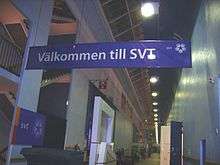
SVT produces drama in several genres and forms.
- Rederiet (1992–2002) was one of the most popular soap operas in Sweden.
Regional programming
Regional content is entirely solely restricted to news which is broadcast on SVT1 and SVT2. The eighteen news programmes are: ABC, Blekingenytt, Gävledala, Hallandsnytt, Jämtlandsnytt, Jönköpingsnytt, Mittnytt, Nordnytt, Smålandsnytt, Sydnytt, Tvärsnytt, Uppland, Värmlandsnytt, Västerbottensnytt, Västmanlandsnytt, Västnytt and Östnytt. The regional news programmes are broadcast on SVT1 at 18.33–18.45 on Mondays to Fridays (18.10–18.15 on Sundays), with a follow-up bulletin at 19.55–20.00. SVT2 also broadcasts regional news following Aktuellt at 21.46–21.56 on Mondays to Thursdays and 21.25–21.30 on Fridays. There are no regional news bulletins on Saturdays.
Children
Kalles klätterträd ran on Sveriges Television starting in 1975 and grew to become one of the most popular children's programmes of the 1970s. The children's strand Bolibompa was broadcast every day at 18.00 on SVT1, before moving to SVTB in August 2008.
Foreign programming
SVT also airs foreign programming, primarily from the United States, United Kingdom and other Nordic countries, in their original audio with Swedish subtitles, as is the case on other Nordic television channels.[9] The only cases in which dubbing is widespread is in programming aimed directly at children who are not expected to have learned reading skills yet. However, for some programmes, viewers may also access 'talking subtitles' through their remote where someone reads the subtitles to viewers (though 'talking subtitles' are not strictly in sync with the original audio as dubbing is). These same practices are also done for segments of local programmes that contain foreign language dialogue.
33% of the national first-time broadcasts consisted of foreign content in 2005. Of all acquired programming (including Swedish programming not produced by SVT) 27% came from the United States, 22% from the United Kingdom, 13% from Sweden, 13% from the other Nordic countries, 6% from France, 4% from Germany and 9% from the rest of Europe.[12]
SVT often cooperates with the other Nordic public broadcasters via Nordvision. Thus, many Danish, Norwegian, Icelandic and Finnish programming air on SVT, while DR, NRK, YLE, KVF and RÚV show Swedish programmes. When there is major breaking news out of Denmark however, SVT may also source live coverage from TV2.

Channels
SVT has five regular channels broadcasting to Sweden:
- SVT1 – The main channel with broad and regional content. The 10 most seen Swedish TV shows in 2006 were shown on this channel. SVT1 HD simulcasts in high definition.
- SVT2 – A channel with slightly narrower programming with an emphasis on culture, current affairs and documentaries. SVT2 HD simulcasts in high definition.
- Barnkanalen (The Children's Channel) – Programmes for children and (pre-)teens.
- Kunskapskanalen (The Knowledge Channel) – Broadcasting debates, seminars and documentaries in cooperation with UR.
- SVT24 – Reruns of programmes from SVT1 and SVT2 in the evening and continuous news updates during the night. Shares frequency with Barnkanalen.
In addition to these channels, SVT has a special events channel called SVT Extra. It is generally unused and was (as of 2006) last used for live coverage during the 2004 Summer Olympic Games. In 2006, SVT launched a high-definition channel called SVT HD, simulcasting HD versions of programmes on the other SVT channels.
All channels, except SVT1 HD and SVT2 HD, are available in most of Sweden through the digital terrestrial television network and encrypted from Thor and Sirius satellites. Until September 2005, both SVT1 and SVT2 were available nationwide via analogue terrestrial transmitters. Cable networks are required to broadcast four SVT channels for free in either digital or analogue form.
SVT World, a mix of the SVT channels, is broadcast on satellite and worldwide via IPTV, and also as a terrestrial channel in Swedish-speaking areas of southern Finland. For rights reasons, SVT World does not show acquired material, such as movies, sport, or English language programming.
SVT1, SVT2, Barnkanalen, SVT24, and Kunskapskanalen are also available through DTT on Åland[13] and can be distributed on Finnish cable networks. In Ostrobothnia, Finland, SVT1, SVT2, SVTB and SVT24 are transmitted through DTT as pay TV to the Swedish-speaking population. The signals from the terrestrial transmitters in Sweden can be received in some areas of Denmark and Norway as well as in northernmost Finland near Sweden. With special equipment reception of Swedish terrestrial transmitters is possible even on some parts of the Finnish coast as well as the Polish and German coast closest to Sweden. Cable networks in the Nordic countries generally redistribute SVT1 and SVT2 often for an additional monthly subscription charge in addition to the subscriber's main package. Some Nordic hotels, especially in Denmark and Norway, also offer SVT1 or SVT2 to guests.
SVT considers their website, svt.se, a channel in its own right. SVT also provides an on-demand service called SVT Play through which most of the programmes produced for SVT and air on its channels are available. However most non-news and non-current event programmes on SVT Play are only available for viewing in Sweden.
Organization
The executive management of SVT is handled by a CEO, appointed by the board. The CEO of SVT is currently Hanna Stjärne who took over the role from Eva Hamilton in 2015. The Chairman of the Board is Lars Engqvist, deputy Prime Minister of the previous Social Democratic government.
SVT is divided into eight operative programme-producing units - four of these are located in Stockholm while the other four are located around the country at regional studios and are based on the ten regional transmission areas which were merged in 2000:
- Malmö - SVT Syd (SVT Malmö and SVT Växjö)
- Gothenburg - SVT Väst (SVT Göteborg)
- Norrköping - SVT Mellansverige (SVT Falun, Dövas TV Leksand, SVT Karlstad, SVT Örebro and SVT Norrköping)
- Umeå - SVT Nord (formerly SVT Luleå, SVT Umeå and SVT Sundsvall)
These four district areas produce networked output and co-ordinate ten of the eleven regional news services broadcast daily on SVT1.
The Stockholm-based units are:
- SVT Nyheter & Samhälle - national news, current affairs, documentaries and the regional news service ABC.
- SVT Sport
- SVT Fiktion - drama, entertainment, youth and children's programming.
- SVTi - multimedia and interactive services.
Chair of the Board of Directors
- Anna-Greta Leijon, 1994–2000
- Allan Larsson, 2000–2005
- Lars Engqvist, 2005 – present
Chief executive officers
Before Sveriges Television was formed in 1978, television broadcasting was controlled by channel controllers. Nils Erik Baehrentz was the controller between 1958-1968. He was succeeded by Håkan Unsgaard who became TV1's controller in 1968 and Örjan Wallquist who became the TV2 controller in 1969.
- Magnus Faxén, 1978–1981
- Sam Nilsson, 1981–1999
- Maria Curman, 2000–2001
- Christina Jutterström, 2001–2006
- Eva Hamilton, 2006 – 2014
- Hanna Stjärne, 2014 – present
When Sam Nilsson retired, the executive chair was split between a CEO and a Programme Officer. This position was abolished in 2007.
- Mikael Olsson, 2000–2000
- Leif Jakobsson, 2001–2007
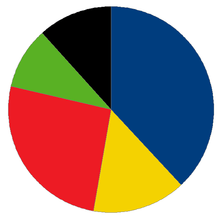
Viewing
Since the arrival of commercial television, SVT's combined viewing share has declined steadily and digital channels have also provided competition. The commercial TV4 became the most watched station in 1995 and maintained its position until 2002, when SVT1 regained the status. TV4 became the most watched channel again 2006.
The combined viewing share of the SVT channels declined from 50% in 1997 to 40% in 2005. SVT was the most watched network in Sweden with a share of 38.3% in 2006, although all three major commercial channels attract a higher share of 15- to 24-year-olds than the two SVT channels combined.[14]
Audience trust
A media study released in 2020 showed that trust in SVT programming polarised the audience.[15] 80-90% of viewers who supported liberal or left-leaning parties Green Party, Swedish Social Democratic Party, Liberals, Left Party and Centre Party had high trust in SVT whereas fewer viewers who supported conservative-leaning parties Christian Democrats (60%), Moderate Party (54%) and Sweden Democrats (30%) had high trust in SVT.[16] This meant that SVT was an issue that polarised the audience more than US president Donald Trump.[15]
Editorial practices
Changing genders of fictional characters in imported programmes
In what was described as an effort to make television series aimed at children and family less sexist, SVT has been changing genders of certain fictional characters (usually anthropomorphic non-human objects) in such series it imported from outside Sweden, a practice that began in 2013.[17][18] For example, in South Korean-Chinese-American animated series Super Wings, the gender of a red airplane named Jett was switched from male to female in Swedish version. Also, in Canadian animated series Trucktown, a male light blue truck named Ted would be known as a female truck of same colour named Linn.[17]
In an interview with Aftonbladet, Pontus Torpvret, purchasing manager at SVT, told that the corporation 'chose which characters to change with an eye to giving girls strong role models', and that it also wanted to showcase boy characters with soft personality, in a bid to defy from traditional portrayals of gender stereotypes. The changes are made with the consent of the production companies, and, in the event of the copyright holder not giving its consent to such changes, SVT would turn down the corporation's offer to purchase the series.[17][18]
See also
- List of Swedish television channels
- NORMOB
- Radiotjänst i Kiruna
- Sveriges Utbildningsradio
- Swedish Broadcasting Commission
- Teracom
- TV4
- Viasat
- CasparCG
References
- "Ny avgift ersätter radio- och tv-avgiften – frågor och svar" [New fee replaces the radio and TV fee — questions and answers]. regeringen.se (in Swedish). Regeringskansliet. 14 November 2018. Retrieved 25 November 2018.
- Television i Sverige - Ägande och struktur, Ministry of Culture, 1996, p. 7
- Television i Sverige - Ägande och struktur, Ministry of Culture, 1996, p. 8
- Television i Sverige - Ägande och struktur, Ministry of Culture, 1996, p. 9
- Larsson, Sören (1998), Allt hände i Aktuellt - 40 år på en nyhetsredaktion, Sveriges Radios förlag, pp. 87–94, ISBN 91-522-1806-6
- Larsson, Sören (1998), Allt hände i Aktuellt - 40 år på en nyhetsredaktion, Sveriges Radios förlag, pp. 115–116, ISBN 91-522-1806-6
- "Svårt med nya kanalnamn". Dagens Nyheter. 8 January 1996.
- Television i Sverige - Ägande och struktur, Ministry of Culture, 1996, p. 10
- Hult, F.M. (2010). Swedish Television as a mechanism for language planning and policy. Language Problems and Language Planning, 34(2), 158-181.
- JMGdata 2000 Journalisternas partisympatier
- Dagens Nyheter, June 9 2006 Archived 4 August 2007 at the Wayback Machine
- In Italy produced with RAI a famous TV series Il Commissario Montalbano. SVT Årsredovisning 2005 page 28 (in Swedish) Archived 30 September 2007 at the Wayback Machine
- "Utsändningar". Ålands radio/tv. Archived from the original on 22 June 2007. Retrieved 29 July 2007.
- "Årsrapport 2006" (PDF). Mms.se.
- "| Förtroendebarometern 2020: Polisen, V och SD får rekordstort förtroende – SVT och SR kraftigt polariserat". Retrieved 13 March 2020.
- "Förtroendebarometern: Fortsatt högt förtroende för public service". SVT Nyheter (in Swedish). 11 March 2020. Retrieved 13 March 2020.
- "Gender aware Swedish TV gives kids' trucks a sex swap". thelocal.se. The Local Europe AB. 16 September 2016. Retrieved 19 November 2019.
- Borgert, Linnéa (16 September 2016). "Barnkanalen byter kön på karaktärer". Aftonbladet (in Swedish). Retrieved 19 November 2019.
External links
| Wikimedia Commons has media related to Sveriges Television. |
- Official website (in Swedish)
- SVT Play, a video on demand service
